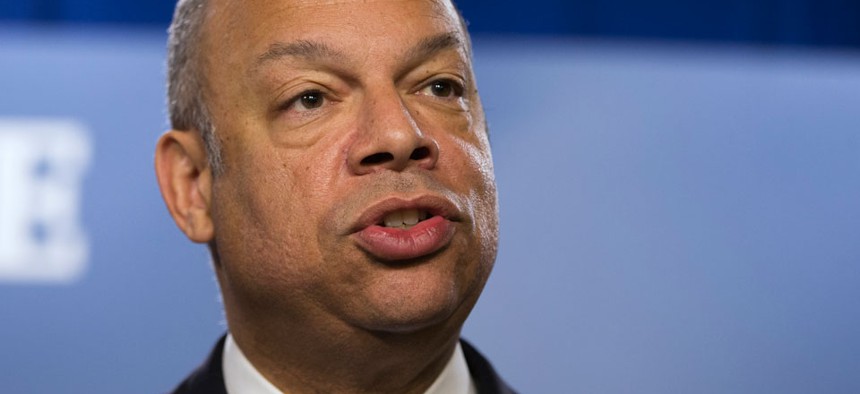Resetting Homeland Security: One Department, One Vision
Unity of effort promises to repair a decade of disjointed planning and budgets.
In April, Homeland Security Department Secretary Jeh Johnson took a bold step toward implementing his vision for the department and the maturation of its capabilities to support the most critical success factor: unity of effort. His memorandum “Strengthening Department Unity of Effort” was a broad, comprehensive, ambitious directive that called for a more cohesive and integrated operating model in two specific areas.
First, he created an inclusive framework to involve DHS components in the day-to-day management of the department. Second, he committed to building capability and capacity to more effectively link strategy to policy, operations, budget, acquisition and performance. Specifically, he directed the establishment of an organizational process to more clearly define requirements for investing resources across the broad mission set—from cybersecurity to data centers to Coast Guard cutters. This is an unending challenge in government, to be sure, but has not been addressed by DHS leadership to this degree before.
The timing couldn’t be better. The secretary has a second opportunity to reset the department’s annual cadence and interaction with the Office of Management and Budget and Congress in support of his vision. Homeland Security has been forced for over a decade to manage against the tyranny of the present, the everyday demands of the annual budget process and oversight by multiple authorizing committees.
The byzantine authorizing oversight structure—which produces an unending stream of hearings, hearing preparation and follow-on questions for the record that no other department is subjected to—is the topic of a stinging Aspen Institute report. Similarly, DHS has never been able to successfully present a Future Year Homeland Security Plan, as required by the legislation that created DHS. A coherent multiyear investment strategy—the desired outcome of the secretary’s memo—can be realized only through a predictable investment funding plan that has been suppressed by mid-level bureaucrats at OMB.
So, why is the timing good?
The 2002 Homeland Security Act, which created DHS, included a requirement for a periodic review of the department’s missions and priorities, similar to the Quadrennial Defense Review. As Coast Guard commandant, I participated in the first Quadrennial Homeland Security Review in 2009. The road was a little bumpy. On entering office in January 2009, the new administration had a very short time to review the fiscal 2010 budget request. It had been put on hold at the direction of President Bush’s team to allow President Obama’s team to review it and provide input. As a result, a budget that normally would have been submitted in early February was not submitted until May.
The next 18 months marked the compression of decisions about two fiscal years, 2010 and 2011. Because of that compression, the strategic analysis and programmatic decisions supporting those two budget years was virtually nonexistent.
At the same time, the department embarked on its first QHSR in the fall of 2009. In the absence of a robust planning process and with the press of the fiscal 2010 and 2011 budget decisions, the 2009 QHSR relied on budgetary themes. The result was a product with limited strategic context.
Fast-forward to 2014. In June, Johnson released the second Quadrennial Homeland Security Review. It is clear that this review is more rigorous in its approach and more inclusive of its stakeholders. While it was passed to the new secretary from his predecessor as a “work in progress,” he quickly seized the opportunity to leverage the work of the DHS career employees who sought to create an analytical framework for future QHSRs and to own the product. While the process continues, it has reaffirmed our nation’s homeland security priorities while framing critical new topics such as biosecurity and managing the flow of goods as part of a reimagined border demanded by our global commons. Most importantly, it clearly reflects a more mature department, building from strengthened stakeholder relationships, functioning governance processes, and a capability for significant analytic rigor.
Key sections of the QHSR underscore the secretary’s Unity of Effort framework. They include:
- Strengthening Departmental Integration
- Increasing Transparency Through Governance
- Building Operational Coordination Capabilities
The secretary’s initial challenge will be to integrate the QHSR recommendations into his near-term budget and policy decisions. But in the long run, he now has the opportunity to integrate the findings into a repeatable, sustainable process. The QHSR can only be effective when it is used to drive decisions and investments across the homeland security enterprise.
Johnson has the opportunity to converge his Unity of Effort strategic vision with the well-reasoned work of the QHSR. He has a willing team. He needs the support of Congress and the administration, and a break from the tyranny of the present.
Thad Allen, an executive vice president at Booz Allen, was commandant of the U.S. Coast Guard from 2006 to 2010.



